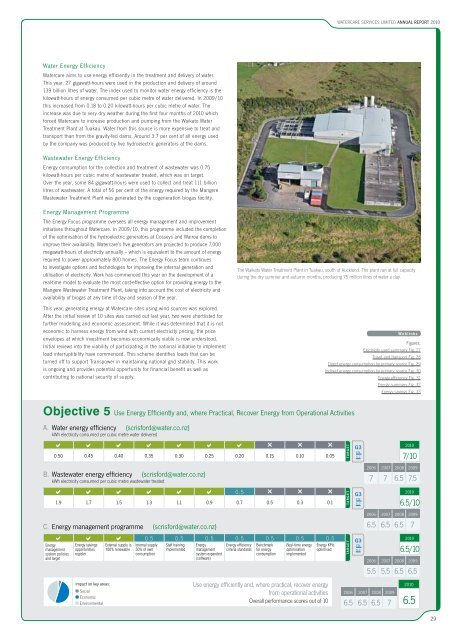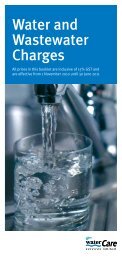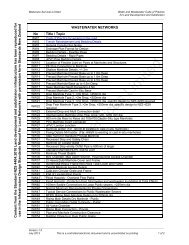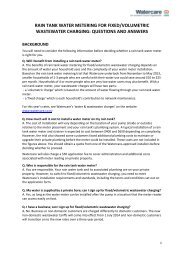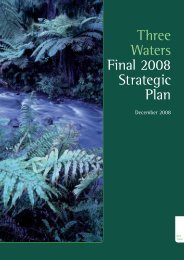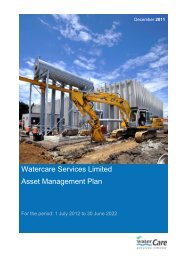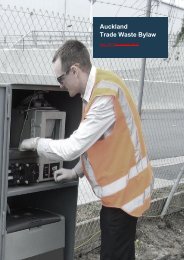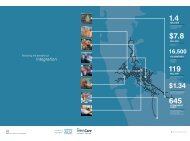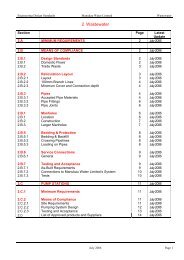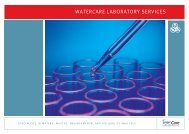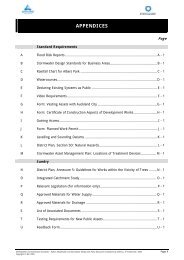2010 ANNUAL REPORT - Watercare
2010 ANNUAL REPORT - Watercare
2010 ANNUAL REPORT - Watercare
- No tags were found...
Create successful ePaper yourself
Turn your PDF publications into a flip-book with our unique Google optimized e-Paper software.
WATERCARE SERVICES LIMITED <strong>ANNUAL</strong> <strong>REPORT</strong> <strong>2010</strong>Water Energy Efficiency<strong>Watercare</strong> aims to use energy efficiently in the treatment and delivery of water.This year, 27 gigawatt-hours were used in the production and delivery of around139 billion litres of water. The index used to monitor water energy efficiency is thekilowatt-hours of energy consumed per cubic metre of water delivered. In 2009/10this increased from 0.18 to 0.20 kilowatt-hours per cubic metre of water. Theincrease was due to very dry weather during the first four months of <strong>2010</strong> whichforced <strong>Watercare</strong> to increase production and pumping from the Waikato WaterTreatment Plant at Tuakau. Water from this source is more expensive to treat andtransport than from the gravity-fed dams. Around 3.7 per cent of all energy usedby the company was produced by five hydroelectric generators at the dams.Wastewater Energy EfficiencyEnergy consumption for the collection and treatment of wastewater was 0.75kilowatt-hours per cubic metre of wastewater treated, which was on target.Over the year, some 84 gigawatt-hours were used to collect and treat 111 billionlitres of wastewater. A total of 56 per cent of the energy required by the MangereWastewater Treatment Plant was generated by the cogeneration biogas facility.Energy Management ProgrammeThe Energy Focus programme oversees all energy management and improvementinitiatives throughout <strong>Watercare</strong>. In 2009/10, this programme included the completionof the optimisation of the hydroelectric generators at Cosseys and Wairoa dams toimprove their availability. <strong>Watercare</strong>’s five generators are projected to produce 7,000megawatt-hours of electricity annually – which is equivalent to the amount of energyrequired to power approximately 800 homes. The Energy Focus team continuesto investigate options and technologies for improving the internal generation andutilisation of electricity. Work has commenced this year on the development of areal-time model to evaluate the most cost-effective option for providing energy to theMangere Wastewater Treatment Plant, taking into account the cost of electricity andavailability of biogas at any time of day and season of the year.This year, generating energy at <strong>Watercare</strong> sites using wind sources was explored.After the initial review of 10 sites was carried out last year, two were shortlisted forfurther modelling and economic assessment. While it was determined that it is noteconomic to harness energy from wind with current electricity pricing, the priceenvelopes at which investment becomes economically viable is now understood.Initial reviews into the viability of participating in the national initiative to implementload interruptibility have commenced. This scheme identifies loads that can beturned off to support Transpower in maintaining national grid stability. This workis ongoing and provides potential opportunity for financial benefit as well ascontributing to national security of supply.The Waikato Water Treatment Plant in Tuakau, south of Auckland. The plant ran at full capacityduring the dry summer and autumn months, producing 75 million litres of water a day.WeblinksFigures:Electricity used summary Fig. 27Travel and transport Fig. 28Direct energy consumption by primary source Fig. 29Indirect energy consumption by primary source Fig. 30Energy efficiency Fig. 31Energy summary Fig. 32Energy savings Fig. 33Objective 5 Use Energy Efficiently and, where Practical, Recover Energy from Operational ActivitiesA. Water energy efficiency (scrisford@water.co.nz)kWh electricity consumed per cubic metre water delivered 0.50 0.45 0.40 0.35 0.30 0.25 0.20 0.15 0.10 0.05B. Wastewater energy efficiency (scrisford@water.co.nz)kWh electricity consumed per cubic metre wastewater treated 0.5 1.9 1.7 1.5 1.3 1.1 0.9 0.7 0.5 0.3 0.1C. Energy management programme (scrisford@water.co.nz) 0.5 0.5 0.5 0.5 0.5 0.5 0.5Energymanagementsystem policiesand targetEnergy savingsopportunitiesregisterImpact on key areas:SocialEconomicEnvironmentalExternal supply is100% renewableInternal supply50% of ownconsumptionStaff trainingimplementedEnergymanagementsystem expanded(software)Energy efficiencycriteria standardsBenchmarkfor energyconsumptionReal-time energyoptimisationimplementedEnergy KPIsoptimisedUse energy efficiently and, where practical, recover energyfrom operational activitiesOverall performance scores out of 10Target Target TargetG3EN5-7G3EN5-7G3EN5-7<strong>2010</strong>7/102006 2007 2008 20097 7 6.5 7.5<strong>2010</strong>6.5/102006 2007 2008 20096.5 6.5 6.5 7<strong>2010</strong>6.5/102006 2007 2008 20095.5 5.5 6.5 6.52006 2007 2008 20096.5 6.5 6.5 7<strong>2010</strong>6.529


